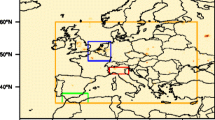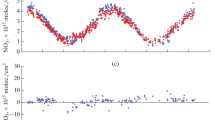Abstract
Phaethon is a ground-based MAX-DOAS system, easily deployed at different locations to address specific air quality problems and support satellite validation studies. Three Phaethon systems have been deployed at different sites in the greater area of Thessaloniki, characterized by diverse local pollution levels representing urban, suburban and rural conditions, aiming at linking tropospheric trace-gas modeling with satellite products. Tropospheric NO2 columns derived at these sites located within an area of about 15 by 30 km, comparable to the size of OMI/Aura pixel, are compared with the satellite retrievals. The OMI/Aura products underestimate the NO2 in the city centre, representing the average pollution levels in the sub-satellite pixel area which, in the case of Thessaloniki, corresponds mostly to rural conditions. In order to minimize the collocation differences in spatial distribution between satellite and ground-based measurements, the former are adjusted by factors that are calculated by means of a high resolution air quality modeling tool, consisting of WRF meteorological model and CAMx air quality model. This approach shows significant improvement in the comparisons between ground-based and satellite-derived observations.
Access provided by CONRICYT-eBooks. Download conference paper PDF
Similar content being viewed by others
Keywords
- Aerosol Optical Depth
- Ozone Monitoring Instrument
- Differential Optical Absorption Spectroscopy
- Campaign Location
- Vertical Column Density
These keywords were added by machine and not by the authors. This process is experimental and the keywords may be updated as the learning algorithm improves.
1 Introduction
Nitrogen dioxide (NO2) is a key pollutant in the troposphere, controlling the ozone production and affecting the oxidation capacity and radiative forcing. The main anthropogenic emission source is fossil fuel combustion in vehicle engines and industrial facilities. Consequently, spatial and temporal heterogeneity in NO2 concentrations is frequently observed in urban and industrial areas. The main NO2 emission sources in the city of Thessaloniki, Greece are transportation, domestic heating and industrial plants. During the last decades, a stabilization trend is recorded in NO2 amounts over the city, while the highest NO2 levels are observed at traffic hotspots in the centre of Thessaloniki (Moussiopoulos et al. 2008).
The monitoring of NO2 concentrations in the troposphere is widely performed by both ground-based and satellite instruments (Celarier et al. 2008; Hendrick et al. 2014). Satellite sensors provide NO2 measurements in a larger scale than the ground-based networks and over areas such as oceans and deserts. However, the spatial and temporal resolution of satellite observations is limited by the sensor’s footprint and its overpass time, respectively. Several studies suggested that the space-borne observations underestimate the tropospheric NO2 levels over urban and industrial regions with variable pollution loadings (Celarier et al. 2008).
Three Phaethon MAX-DOAS instruments have been installed at different locations, which are characterized by diverse atmospheric conditions, within the greater area of Thessaloniki and performed tropospheric NO2 measurements. These observations are compared with OMI/Aura collocations. In order to improve the comparison results, the OMI data are adjusted using factors that are calculated by an air quality modeling system, consisting of CAMx air quality model and WRF meteorological model.
2 Data and Methodology
Phaethon #1 has been operating on the roof of the Physics Department in the Aristotle University of Thessaloniki located at the city centre (urban conditions, UC). Phaethon #2 was installed at a site with rural conditions (RC) near the sea shore about 26 km away from the city from 1 November 2014 to 31 January 2015. Finally Phaethon #3 was installed at the Alexander Technological Educational Institute of Thessaloniki (ATEITH) located in an area with suburban conditions (SC) to the north-west of the city and from 20 January to 11 May 2015.
For the analysis of the scattered light measurements the Differential Optical Absorption Spectroscopy (DOAS) technique was applied using the QDOAS v2.109_3 software developed by BIRA-IASB and S[&]T. The analysis was done in the spectral window 400–450 nm; the broadband absorption features were removed by a 4th degree polynomial; and a second-order linear offset and a Ring effect spectrum, calculated according to Chance and Spurr (1997), were included in analysis. Along with NO2, absorption by O3, O4 and H2O were also taken into account. The zenith spectrum of each elevation sequence was used as reference in order to minimize the stratospheric component in the calculated off-axis differential Slant Column Densities (dSCDs) (Hoenninger et al. 2004). The tropospheric vertical column density (VCD) can be calculated for each elevation angle by:
where the dAMFtrop is the tropospheric differential air mass factor which represents the absorption enhancement in the light path.
For the calculation of tropospheric NO2 AMFs the modelling package libRadtran and a pseudo-spherical discrete ordinate radiative transfer method were used. Typical values were assumed for the aerosol single scattering albedo (0.95), the aerosol asymmetry factor (0.7) and the surface albedo (0.1). Mean vertical profiles were derived by the air quality modelling tool consisting of CAMx and WRF. The mean aerosol optical depth (AOD) vertical profile was derived for the period 2001–2007 by a LIDAR system operating at LAP (Giannakaki et al. 2010) and was used for all three locations, as suggested by Kazadzis et al. (2009) who found a small spatial variability in AOD and its profile at these locations. The aerosol profile was scaled using different AOD values in the range 0–1.5. AMF look up tables (LUTs) were constructed for each measurement location separately with variables the AOD, the solar zenith angle, and the viewing angles (elevation and azimuth). The AMF corresponding to each measurement is calculated by multi-linear interpolation, using the AOD measurements from the CIMEL sun-photometer operating in LAP/AUTH (http://aeronet.gsfc.nasa.gov/).
The Ozone Monitoring Instrument (OMI) is one of four instruments aboard the NASA EOS-Aura satellite. OMI is a nadir viewing, ultraviolet-visible (270 to 500 nm) imaging spectrometer with pixel size at the nadir 13 × 25 km that was contributed by the Netherlands and Finland (Levelt et al. 2006). An overpass data set was extracted from OMI/Aura observations for each of the campaign locations. The operational total and tropospheric NO2 columns are generated by National Aeronautics and Space Administration (NASA) and distributed by the Aura Validation Data Center (AVDC) (http://avdc.gsfc.nasa.gov/).
The air quality modeling tool employed for this study consisted of the Comprehensive Air Quality Model with Extensions (CAMx, version 5.3) (ENVIRON 2010), off-line coupled with the Weather Research and Forecasting—Advanced Research Weather (WRF—ARW, version 3.5.1) (Skamarock et al. 2008). Simulations were carried out for the period November 2014–May 2015 over the grid covering the greater area of Thessaloniki with 2 km spatial resolution. The vertical profile extends up to 10 km above ground-level and contains 22 layers of varying thickness with higher resolution near the ground.
The simulated NO2 mixing ratio data are available at hourly averaged values per layer for each cell of the domain. These hourly mean vertical profiles of NO2 concentration were integrated over height and the tropospheric NO2 VCDs were estimated. The ratio of the tropospheric NO2 column of the grid cell that includes the measurement location and the averaged column over the sub-satellite pixel area (7 × 13 cells) OMI measurements in order to minimize the differences between ground-based and satellite observations due to different spatial distribution.
3 Results
The ratios calculated according to the method described above, as well as the reconstructed satellite observations are presented in Fig. 1. In the centre of Thessaloniki (UC) the ratio is in the range 2–2.5 with smaller values observed during winter and higher during spring months. For the other two campaign locations the estimated ratio is much smaller, and it is very close to unit for the RC site. The simulated ratios for the SC location are slightly lower than unit for most part of the time series with large variations observed in a few cases. This can be attributed to the fact that this site is located ~ 13 km west of the city centre and due to the pixel footprint size (13 × 25 km) the OMI measurements can be affected by the heavy loadings observed in the city centre, Hence, the reconstructed OMI overpass data over the SC site are slightly lower than the original.
In Fig. 2 the comparison of ground-based and satellite collocations before and after the OMI data are adjusted is presented. The comparison over the UC area is significantly improved with the slope of the fitted least squares regression line changing from ~ 0.2 to ~ 0.45. The collocations over the two other campaign locations are generally unaffected by the adjustment, except for a few OMI observations over the SC site that are reduced and this results to a slightly improved comparison with the Phaethon data.
4 Conclusions
Three Phaethon MAX-DOAS systems have been deployed and performed tropospheric NO2 column measurements at three locations within the greater area of Thessaloniki, Greece, characterized by different atmospheric pollution loadings. The derived data are compared with OMI/Aura collocations in order to assess the differences in spatial distribution between satellite and ground-based observations. The comparison revealed an average underestimation in tropospheric NO2 column over the urban area from the satellite sensor of about 6x1015 molecules/cm2 and very good agreement over the other two locations. The OMI data set was reconstructed by means of adjustment factors derived from simulations of an air quality modeling system. The method applied resulted in a significant improvement in collocation comparison over the urban region.
References
Celarier EA et al (2008) Validation of Ozone Monitoring Instrument nitrogen dioxide columns, J. Geophys. Res., 113, D15S15, doi:10.1029/2007JD008908
ENVIRON (2010) User’s guide CAMx—comprehensive air quality model with extensions, Version 5.30, ENVIRON International Corporation, 415.899.0700, December 2010
Giannakaki E, Balis DS, Amiridis V, Zerefos C (2010) Optical properties of different aerosol types: seven years of combined Raman-elastic backscatter lidar measurements in Thessaloniki, Greece. Atmos. Meas. Tech. 3:569–578. doi:10.5194/amt-3-569-2010
Hendrick F, Müller J-F, Clémer K, Wang P, De Mazière M, Fayt C, Gielen C, Hermans C, Ma JZ, Pinardi G, Stavrakou T, Vlemmix T, Van Roozendael M (2014) Four years of ground-based MAX-DOAS observations of HONO and NO2 in the Beijing area. Atmos Chem Phys 14:765–781. doi:10.5194/acp-14-765-2014
Hönninger G, von Friedeburg C, Platt U (2004) Multi axis differential optical absorption spectroscopy (MAX-DOAS). Atmos Chem Phys 4:231–254. doi:10.5194/acp-4-231-2004
Kazadzis S, Bais AF, Balis D, Kouremeti N, Zempila M, Arola A, Giannakaki E, Amiridis V, Kazantzidis A (2009) Spatial and temporal UV irradiance and aerosol variability within the area of an OMI satellite pixel. Atmos Chem Phys 9:4593–4601. doi:10.5194/acp-9-4593-2009
Levelt, PF, J. van den Oord GH, Dobber MR, Ma ̈lkki A, Visser H, de Vries J, Stammes P, Lundell J, Saari H (2006) The ozone monitoring instrument, IEEE Trans. Geosci. Remote Sens, 44(5), 1093–1101, doi:10.1109/TGRS.2006.872333
Moussiopoulos Ν, Vlachokostas Ch, Tsilingiridis G, Douros I, Hourdakis E, Naneris C, Sidiropoulos C (2008) Air quality status in Greater Thessaloniki Area and the emission reductions needed for attaining the EU air quality legislation. Sci Total Environ 407:1268–1285. doi:10.1016/j.scitotenv.2008.10.034
Skamarock WC, Klemp JB, Dudhia J et al (2008) A description of the advanced research WRF version 3. NCAR Technical Note (NCAR/TN—475 + STR), Boulder, Colorado, USA
Acknowledgments
This study was supported by the Operational Program “Education and Lifelong Learning” of the National Strategic Reference Framework (NSRF), Research Funding Program: Aristeia, AVANTI, and the FP7-SPACE-2013-1 QA4ECV (Grant agreement no: 607405).
Author information
Authors and Affiliations
Corresponding author
Editor information
Editors and Affiliations
Rights and permissions
Copyright information
© 2017 Springer International Publishing Switzerland
About this paper
Cite this paper
Drosoglou, T. et al. (2017). Comparison of Ground-Based Tropospheric NO2 Columns with OMI/Aura Products in the Greater Area of Thessaloniki by Means of an Air Quality Modeling Tool. In: Karacostas, T., Bais, A., Nastos, P. (eds) Perspectives on Atmospheric Sciences. Springer Atmospheric Sciences. Springer, Cham. https://doi.org/10.1007/978-3-319-35095-0_153
Download citation
DOI: https://doi.org/10.1007/978-3-319-35095-0_153
Published:
Publisher Name: Springer, Cham
Print ISBN: 978-3-319-35094-3
Online ISBN: 978-3-319-35095-0
eBook Packages: Earth and Environmental ScienceEarth and Environmental Science (R0)






